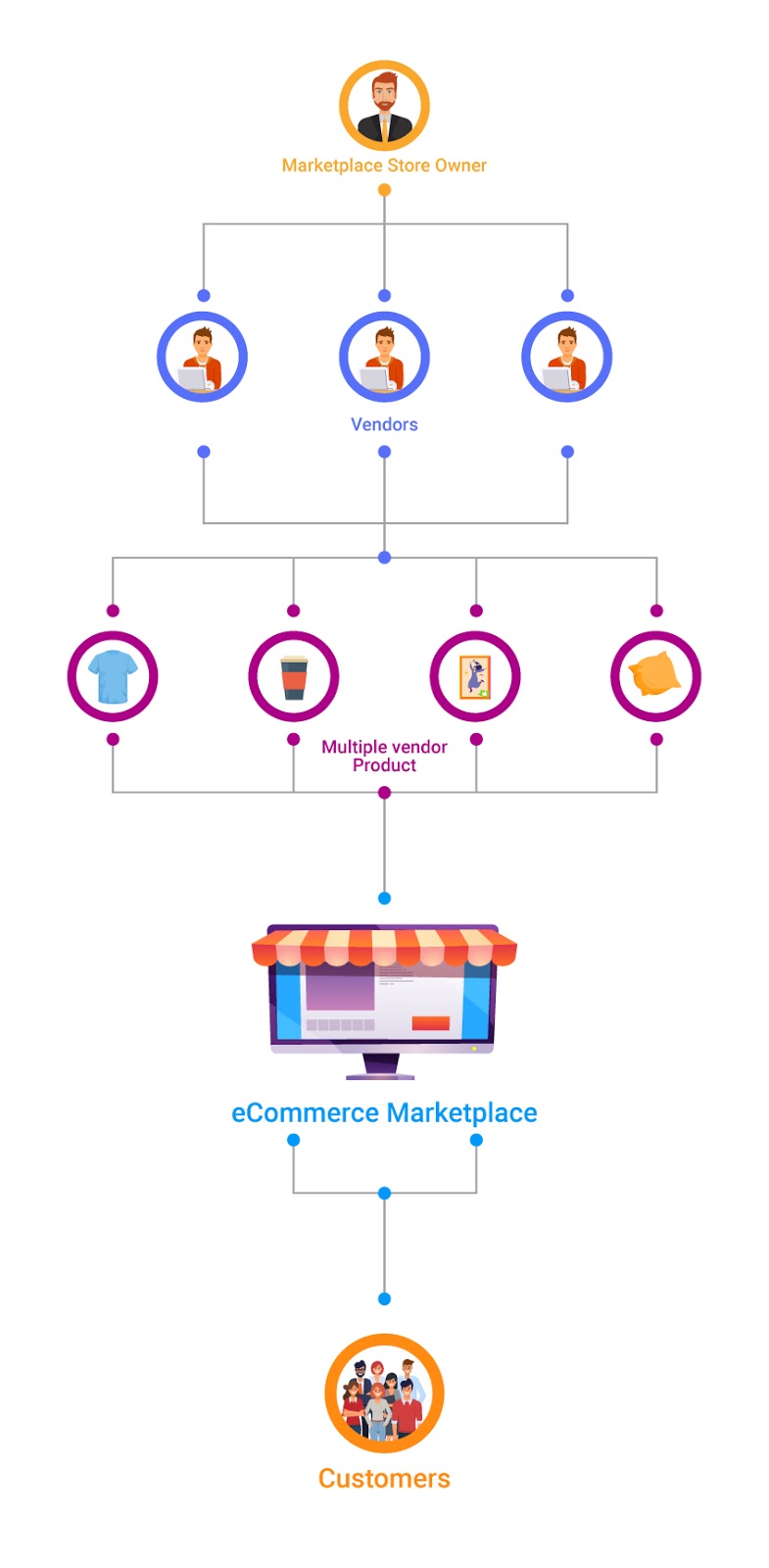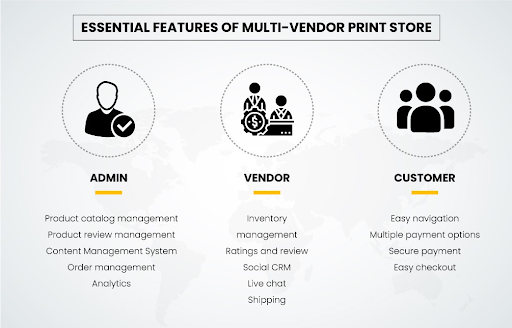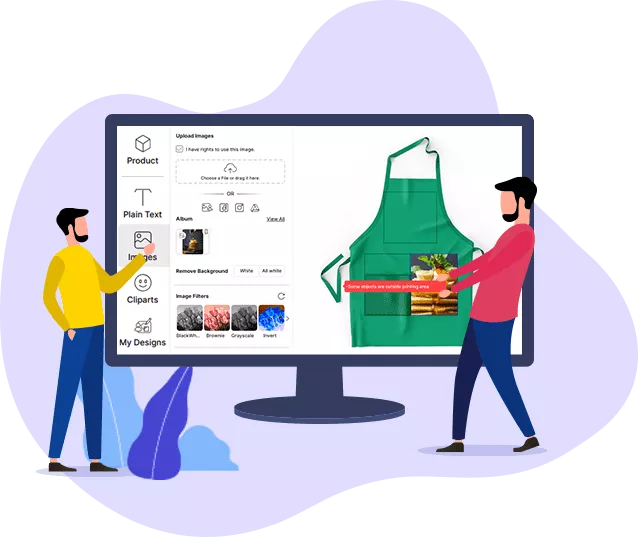
Let’s say you have a t-shirt business. How many t-shirts would you ideally sell every day?
3, 12, or 30 maybe?
What if you could sell 100 t-shirts daily with no headache of logistics, inventory, or pricing?
Yes, that’s possible. With a multi-vendor print store!
If you are a business owner who has just started, and are targeting big, then this guide is for you. We will discuss all about how a multi-vendor store works, how it can be beneficial to you, and what are the essential elements of building it.
Multi-vendor Store Defined
Take Amazon, for instance. Amazon is a huge eCommerce hub where there are different brands of different industries. Customers pay for a product they like, and it arrives at their doorstep. This entire buying and selling process takes place on a single platform.
In the same way, a multi-vendor store hosts multiple vendors and gives them the opportunity to sell online on a single platform. In simpler words – the platform works as mediator between hundreds of product providers and customers. It’s a win-win for all the three parties involved (store owner, vendor, and customer). The vendor can start selling online by registering and creating a site from ready-made themes on the multi-store itself. The customer can browse through thousands of different products at a single store, and the owner gets an opportunity to attract visitors and earn by charging a fee from each purchase made on the vendor’s website.
The responsibility of running the stores lies with different third-party vendors while as a business owner, you handle orders, shipping, and payment management. This type of business model offers a wider reach, better scalability, higher profitability, and ease of doing business. That’s why entrepreneurs are turning towards a multi-vendor store.
Here’s how a multi-vendor store works:

Multi-vendor Store: A Master Stroke for Your Business
Having a multi-vendor store is advantageous because:
– No longer managing ‘tough’ tasks – as a business owner, you know how difficult it is to manage logistics, inventories, product additions, upgrades, pricing and several other details while running an online store. This requires great effort plus a big team. A multi-vendor store will take away these woes. Now it’s on your vendors to take care of these things while you focus on other important tasks such as marketing, and brand promotion.
– A vast range of products – The reason why companies like Amazon, and eBay are successful is because they offer a wide field of products. Do you think these brands would be successful if they had a single product?
By welcoming new vendors, you start selling new products and product categories. Your potential customers browse one marketplace and purchase what they like. This enhances the shopping experience. Secondly, it goes without saying that when you have a huge variety to offer, you are bound to attract more customers.
– Lesser expenses – sellers on your store will manage their store, inventory, packaging, etc. which nullifies the need to hire a staff. This will save you more money which you can spend on marketing your store.
– No inventory – inventory management can break the back of any startup owner. With a multi-vendor store, inventory management, storing, warehousing, packing, etc. is entirely the responsibility of the vendor. This exclusion of inventory saves you time, space, and cost.
– Commissions – As a multi-store owner, you get a commission for the following services:
-> Commission for posting products
-> Commission for each product sold on the marketplace
-> Commission for each purchase
It’s on you to either charge a flat fee or percentage of price. Other than commission, you can earn a few bucks by providing paid services. For instance, vendors with a paid and upgraded account get additional features and benefits.
Multi-store Components
As a multi-store owner, it is crucial to establish a balance between tasks done by the vendor and tasks which are the owner’s responsibility. Failing to do so can be a disaster for your store. Thus, understanding these components will make your work easy.
– Inventory – to effectively manage inventory in a way that your customers get what they are looking for, you have two options. (a) let the vendors add their product themselves, and (b) add the products yourself. We suggest you let the vendors manage the inventory because adding products for 15 different vendors yourself is not a feasible option. Plus, these vendors will know their products and its description in and out. However, always make sure to check the quality of the products before they go live.
– Managing Orders – you have every product that your customers ask. But your order management system sucks. Too bad! Managing orders is necessary to provide great customer experience. The best order management strategy for a multi-vendor store is: give access to the store dashboard to the vendor to handle the orders while you keep a check on things going smoothly.
– Shipping – in a multi-vendor store, the vendors have the inventory. So, it is their responsibility to make sure orders are shipped. However, as a store owner, you have the power to authorize various shipping methods. It’s your call to decide shipping yourself or leave it on the vendors. But always keep a track of order shipment with tracking numbers.
– Pricing Model – the payment options for the vendors include (a) a scheduled payment where the vendor receives the commission in a stipulated time. For example, every week. (b) pay the vendors whenever a sale happens.
Vendors are an important part of your store. Ensure they are happy and satisfied by paying them in a timely manner.
Key Requirements to Create a Multi-vendor Print Store
Development Platform
The first step is to sign up with an eCommerce platform that supports multi-vendor functionality, on-demand printing solutions and dropshipping. Here, you can go for an open-source platform or SaaS-based platform. There are a variety of solutions available such as Shopify, Magento, WooCommerce, and more. The best is to consult experts and choose that fits your requirements. The development platform you choose will be of the specific kind.
Launch a multi-vendor print store with on-demand printing functionality! Our custom development services are tailored to your needs, ensuring a user-friendly, scalable, and fully functional store. Plus, we also provide ongoing support and maintenance.
Essential Features of Multi-Vendor Print Store

Product Design Tool
The appeal of personalization is high among customers. 86% of consumers say personalization plays an important role in their purchasing decisions. This suggests that not prioritizing tailored experiences will keep you behind in the race.
The best way to leverage the power of personalization is by integrating a design tool with your multi-vendor store. This tool gives the customer the power to design their own products while you print and ship it to them. Providing this service will give you an advantage of attracting new customers and increasing sales.
The product designer tool by PrintXpand allows you to integrate a customizable design feature into your multi-vendor store, allowing your customers to personalize a wide range of products with their own unique designs and images.

This lets you transform your marketplace into a fully interactive design studio, where your customers can let their creativity run wild and create products that are truly one-of-a-kind.
They can add their favorite quote to a t-shirt, create a personalized phone case, or add their own flair to a coffee mug.
This kind of personalized product design experience can boost customer engagement and satisfaction, increase conversion rates, and drive sales growth. And with PrintXpand’ user-friendly interface and customizable features, it’s easy to get started and start seeing results.
Promoting Your Store
Once you launch the store, you need to dabble in several free as well as paid marketing strategies such as social media marketing, email marketing, advertisements, etc. to attract more vendors and users. The biggest advantage you have is having a design tool. You need to tell the shoppers how powerful the tool is and then see them flock to your store.
Conclusion
That’s it, folks! To conclude, we’ll give a quick overview of what we discussed.
By launching a multi-vendor print store, you open your enterprise to more opportunities. Think of it this way – if today you manage to sell x products, single handedly, then imagine what will be the scenario if you have 10 other vendors working on your platform! The result is going to be 10x! And then add a robust tool that your customers love!
If you’re ready to take the next step in launching your own multi-vendor print store, contact us today. Our team is ready to assist you in creating a successful and profitable online store.
All product and company names are trademarks™, registered® or copyright© trademarks of their respective holders. Use of them does not imply any affiliation with or endorsement by them.



